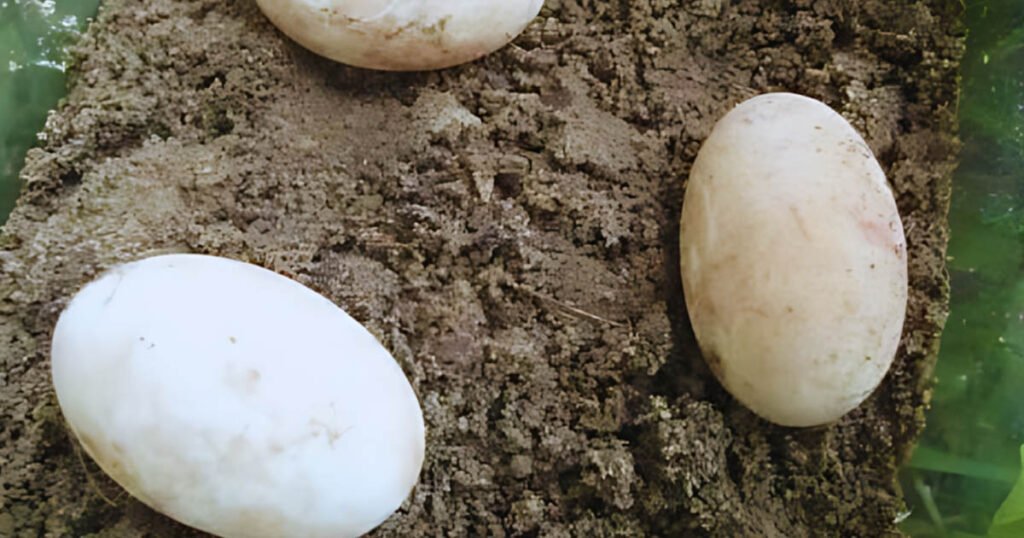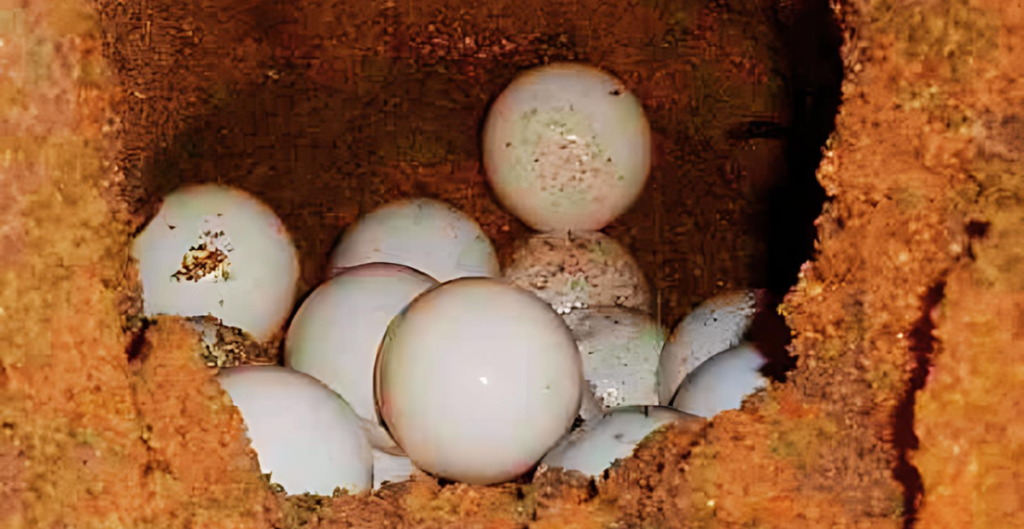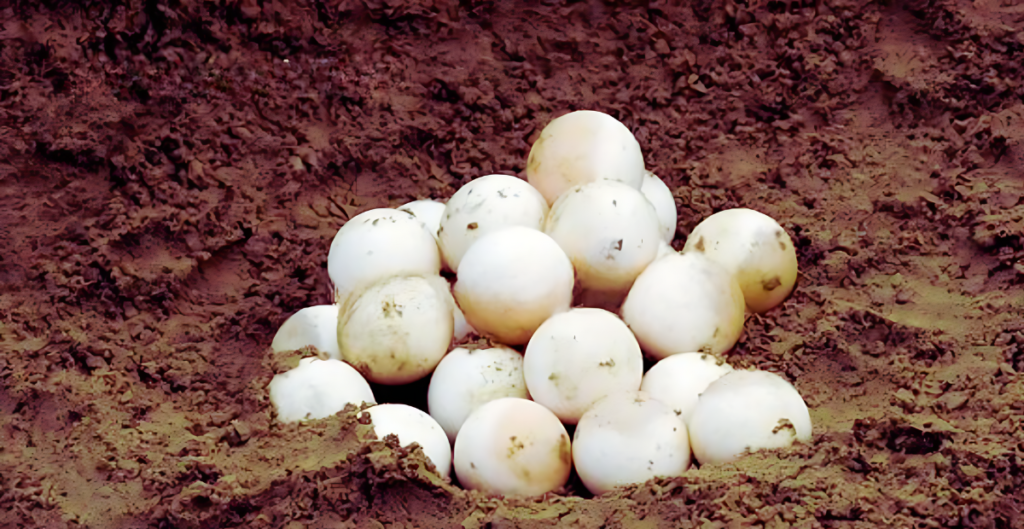Among the 12,000 species of living reptiles, turtles are particularly fascinating creatures. Their slow-moving nature has captivated the hearts of many, making them popular pets. You may be aware that turtles reproduce by laying eggs. If you’re unfamiliar with turtle eggs, you might wonder, “What do turtle eggs look like?” Among the 356 species of turtles, including tortoises and terrapins, the fundamental appearance of the egg remains relatively consistent.
However, there are variations among species regarding the egg’s shape, color, and size. Turtle eggs are unique to each species, which contributes to their visual look. In this article, we’ll explore turtle eggs and provide insights into how they look and how they differ from one species to another. Let’s take a look into the wonder of turtle reproduction and discover the fascinating features of their eggs!
Table of Contents
What Do Turtle Eggs Look Like?

Turtle eggs have a fascinating array of features to consider. Initially, these eggs boast a striking bluish-white shade that catches observers’ attention. However, within a mere two days, a transformation occurs as the shell adopts a chalky white appearance, signaling the onset of incubation.
Egg Size and Shape
Turtle eggs are similar in size to ping-pong balls. Certain turtle eggs are identical to elongated shapes, taking on a cylindrical shape rather than a perfectly spherical one.
A group or batch of eggs laid by a female turtle is often called a “clutch.” Their eggs are commonly found hidden in underground pits to shield them from predators and environmental hazards. This nesting strategy helps ensure the safety and protection of eggs during the incubation period. Interestingly, once laid, mother turtles do not return to tend to their eggs, leaving them outside thinking the place is a safe zone for eggs.
Texture and Sensitivity
Turtle eggs are soft and delicate, particularly at the beginning, with a fragile outer shell that requires gentle care and protection. Turtle eggs typically resemble golf balls (like ping-pong balls as we mentioned above) in shape. However slight differences can arise, often because of calcium particles released during egg formation.
Furthermore, it’s essential to note that the location of the nest plays a big role in turtle egg survival. Female turtles meticulously select suitable sites, ensuring optimal conditions for successful incubation. These nests are meticulously covered with sand and foliage, providing a protective shield against external threats.
Turtle eggs are not merely ordinary spheres but intricate wonders of nature, with their own unique characteristics and requirements.
What Do Box Turtle Eggs Look Like?
When it comes to turtle eggs, box turtle eggs are different in color. Unlike the familiar white or bluish hue of sea turtle eggs, box turtle eggs are light brown. They have a distinct texture, feeling soft, almost like rubber or leather, unlike the hard shells of bird eggs.
While most box turtle eggs are rounded like ping-pong balls, there are exceptions. Some species, such as the eastern box turtle, may lay elongated eggs, adding to the variety in appearance.
Incubation and Hatching
Box turtle eggs have their timeline. They are typically laid in two clutches per year, with some taking up to 120 days to hatch. The duration of incubation is crucial, not just for embryo development but also for determining their gender. Like many other turtle species, box turtle offspring are influenced by the temperature at which eggs are kept during incubation.
Breeding and Reproduction
Box turtle breeding is a seasonal affair. Females usually plant eggs between May and July. The process is carried out with precision, with the female carefully digging a nest during dusk and depositing each egg with care. Interestingly, each clutch contains only four to five eggs, ensuring that the mother can provide ample attention to each one. Once laid, the eggs undergo an incubation period of 50 to 90 days, during which they develop within the safety of their nest.
What Do Sea Turtle Eggs Look Like?

Sea turtle eggs are similar to ping-pong balls in shape. We are familiar with chicken eggs, but turtle eggs are nothing like chicken eggs. Unlike the hard shells of chicken eggs, sea turtle eggs have a soft, fragile surface, so they need extra attention as they grow. It’s crucial to handle them with care from the moment they’re laid until they hatch.
Different Egg Textures
Sea turtles typically lay 80-120 eggs, while leatherback sea turtles lay 90 larger eggs. The eggs vary in texture; some have hard shells rich in calcium, while others are soft and leathery.
The eggs have a papery to leathery or rubbery texture, ensuring they don’t break easily when dropped into the nest. They’re surrounded by thick, clear mucus for protection.
Baby turtles inside the eggs breathe through a special membrane. They can’t live if they stay underwater for too long. Disturbed sea turtles may return to the sea and nest elsewhere later.
In the US, only permitted researchers can handle sea turtles or their eggs.
What Do Snapping Turtle Eggs Look Like?

Snapping turtle eggs are small, white, and perfectly round with a soft, leathery texture. After mating, females lay eggs in a shallow nest near the shore.
Female snapping turtles dig bowl-shaped nests in sunny spots with good drainage with their powerful back legs. Over several hours, the female turtle lays approximately 20 to 40 creamy white, ping-pong ball-sized eggs.
Once the eggs are laid, the female covers the nest with soil and leaves, concealing it from predators. The eggs remain in the nest for about two months until they hatch. During this time, the eggs are vulnerable to predators and environmental factors. They rely on the soil’s warmth for incubation.
After the incubation period, the hatchlings emerge from the eggs and swim to the water. They are small and vulnerable at this stage, facing predator threats.
What Do Painted Turtle Eggs Look Like?
Painted turtle eggs are distinctively white, smooth, and oval-shaped, measuring about 31 mm (1.2 in) in length. Their incubation period lasts from 72 to 80 days.
The temperature of the nest decides the gender of painted turtle hatchlings—cooler temperatures lead to males, while warmer temperatures lead to females. Typically, hatching occurs between late August and early September.
Female painted turtles carefully choose nesting spots with ample sunlight and easy-to-dig terrain, such as gravel pits, sand banks, lawns, or grassy areas. Using their back feet, they excavate a cavity about four inches deep and lay 4 to 8 soft, oval-shaped eggs.
Interestingly, female painted turtles may still develop eggs without mating. This is because they retain sperm from previous mating encounters for years.
What Do Red-Eared Slider Turtle Eggs Look Like?
Red-eared slider eggs are typically oval and small, measuring about 0.6 inches long and 0.4 inches in diameter. They’re initially white but may turn yellow as they age.
A female red-eared slider can lay anywhere from 2 to 30 eggs in a single clutch. These eggs are often oval but may also be round. Unlike chicken eggs, their shells are relatively soft, similar to hard-boiled eggshells.
In the wild, red-eared sliders usually lay eggs between May and July. During this time, it’s essential to watch for signs of pregnancy in your pet slider. Mating generally occurs from April to early July, and after mating, female sliders take 3 to 6 weeks to become pregnant.
FAQ
What Color Are Turtle Eggs?
Turtles’ egg color base is normally white. White can sometimes have a bluish tone, pinkish tone, or yellowish tone as well as other colors. The color tone depends on the variety of different turtle species.
What Do Freshwater Turtle Eggs Look Like?
Freshwater turtle eggs typically appear white and round, resembling golf balls. They have a soft and leathery texture, similar to eggs from snakes or lizards. After laying the eggs, the mother turtle covers the nest with sand and camouflages the surrounding area using her front flippers.
Read More: Do Barnacles Hurt Turtles?
Wrapping Up
To wrap up, now you know what do turtle eggs look like! These tiny eggs come in various shapes, sizes, and colors, but they’re generally round or oval with soft, leathery shells. These amazing reptiles’ life cycles can’t continue without the eggs they lay, regardless of whether they’re buried in the sand or nestled in soil.
Watch out for these eggs next time you’re near a turtle nesting site and look at nature’s wonders!
